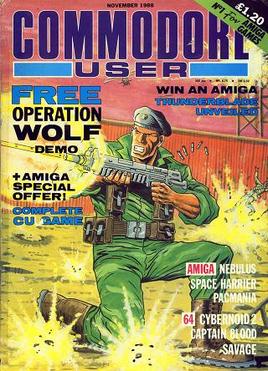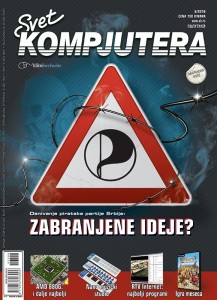
The Commodore 1541 is a floppy disk drive which was made by Commodore International for the Commodore 64 (C64), Commodore's most popular home computer. The best-known floppy disk drive for the C64, the 1541 is a single-sided 170-kilobyte drive for 5¼" disks. The 1541 directly followed the Commodore 1540.

The Commodore 64, also known as the C64, is an 8-bit home computer introduced in January 1982 by Commodore International. It has been listed in the Guinness World Records as the highest-selling single computer model of all time, with independent estimates placing the number sold between 12.5 and 17 million units. Volume production started in early 1982, marketing in August for US$595. Preceded by the VIC-20 and Commodore PET, the C64 took its name from its 64 kilobytes(65,536 bytes) of RAM. With support for multicolor sprites and a custom chip for waveform generation, the C64 could create superior visuals and audio compared to systems without such custom hardware.

A microcomputer is a small, relatively inexpensive computer having a central processing unit (CPU) made out of a microprocessor. The computer also includes memory and input/output (I/O) circuitry together mounted on a printed circuit board (PCB). Microcomputers became popular in the 1970s and 1980s with the advent of increasingly powerful microprocessors. The predecessors to these computers, mainframes and minicomputers, were comparatively much larger and more expensive. Many microcomputers are also personal computers. An early use of the term "personal computer" in 1962 predates microprocessor-based designs. (See "Personal Computer: Computers at Companies" reference below). A "microcomputer" used as an embedded control system may have no human-readable input and output devices. "Personal computer" may be used generically or may denote an IBM PC compatible machine.
Programmed Inquiry, Learning, or Teaching (PILOT) is a simple high-level programming language developed in the 1960s. Like its younger sibling LOGO, it was an early foray into the technology of computer-assisted instruction.

Commodore User, later renamed to CU Amiga, is a series of American and British magazines published by Commodore International.

Svet kompjutera is a computer magazine published in Serbia. It has the highest circulation in the country. Svet kompjutera deals with subjects on home, PC computers, tablet computers, smartphones, and video game consoles as well as their use for work and entertainment. Its aim is to inform the readers about the latest events in Serbian and world computer scene and to present products that are interesting for its readers. Its editorial staff sees this as their main task to advise computer users on how to use their hardware and software in the best way.

Run was an American computer magazine published monthly by IDG Communications with its first issue debuting in January 1984. Bi-monthly publishing began in June/July 1990, and went on until the magazine folded in November/December 1992. In its heyday, Run's monthly circulation was in the 200,000–300,000 range. Folio, the trade journal of the magazine industry, rated it as the second fastest-growing U.S. magazine of 1985.

A type-in program or type-in listing was computer source code printed in a home computer magazine or book. It was meant to be entered via the keyboard by the reader and then saved to cassette tape or floppy disk. The result was a usable game, utility, or application program.
Newsfield Publications Ltd was a British magazine publisher during the 1980s and early 1990s.

The VIC-1211 Super Expander is a cartridge for the VIC-20 home computer. It was designed to provide several extensions to the BASIC interpreter on the computer, mostly to help with programming graphics and sound. It also provided 3 kB of extra RAM. The cartridge was created by Commodore Business Machines (CBM) and released in 1981.

Loadstar was a disk magazine for the Commodore 64 computer, published starting in 1984 and ceasing publication in 2007 with its unreleased 250th issue. It derived its name from the command commonly used to execute commercial software from a Commodore 1541 disk: LOAD "*",8,1, with inspiration from the word "lodestar".

The Socialist Federal Republic of Yugoslavia (SFRY) was a socialist country that existed in the second half of the 20th century. Being socialist meant that strict technology import rules and regulations shaped the development of computer history in the country, unlike in the Western world. However, since it was a non-aligned country, it had no ties to the Soviet Bloc either. One of the major ideas contributing to the development of any technology in SFRY was the apparent need to be independent of foreign suppliers for spare parts, fueling domestic computer development.

Kilobaud Microcomputing was a magazine dedicated to the computer homebrew hobbyists from 1977 to 1983. It was one of the three influential computer magazines of the 1970s, along with BYTE and Creative Computing. It focused mostly on the kit-build market, rather than the pre-assembled home computers that emerged, and as the kit market declined in the early 1980s, Kilobaud lost relevance and closed in 1983. After this, company continued publishing other magazines dedicated to particular platforms rather than the kit market.

The history of the personal computer as a mass-market consumer electronic device began with the microcomputer revolution of the 1970s. A personal computer is one intended for interactive individual use, as opposed to a mainframe computer where the end user's requests are filtered through operating staff, or a time-sharing system in which one large processor is shared by many individuals. After the development of the microprocessor, individual personal computers were low enough in cost that they eventually became affordable consumer goods. Early personal computers – generally called microcomputers – were sold often in electronic kit form and in limited numbers, and were of interest mostly to hobbyists and technicians.

The British Broadcasting Corporation Microcomputer System, or BBC Micro, is a series of microcomputers designed and built by Acorn Computers Limited in the 1980s for the Computer Literacy Project of the BBC. Designed with an emphasis on education, it was notable for its ruggedness, expandability, and the quality of its operating system. An accompanying 1982 television series, The Computer Programme, featuring Chris Serle learning to use the machine, was broadcast on BBC2.
Computer User is a computer magazine that was founded in 1982, and which, after several owners and fundamental changes, is still in business today online as computeruser.com. It should not be confused with a magazine published in 1983-1984 by McPheeters, Wolfe & Jones that was also titled Computer User, but with the subtitle "For the Tandy/Radio Shack System".

The MRB Z 1013 was an East German single-board computer produced by VEB Robotron Riesa, which was primarily intended for private use and educational institutions. It was powered by a U880 processor and sold together with a membrane keyboard. Initially, the kit was equipped with 16 kilobytes of DRAM, which was later replaced by a 64 KB version.

Home computers were a class of microcomputers that entered the market in 1977 and became common during the 1980s. They were marketed to consumers as affordable and accessible computers that, for the first time, were intended for the use of a single, non-technical user. These computers were a distinct market segment that typically cost much less than business, scientific, or engineering-oriented computers of the time, such as those running CP/M or the IBM PC, and were generally less powerful in terms of memory and expandability. However, a home computer often had better graphics and sound than contemporary business computers. Their most common uses were word processing, playing video games, and programming.

Byte was a microcomputer magazine, influential in the late 1970s and throughout the 1980s because of its wide-ranging editorial coverage.

The Thompson Twins Adventure is a 1984 graphic adventure game that was distributed by Computer and Video Games magazine as a promotional 7" flexi disc "freebie" along with its October 1984 issue. The game is based on the Thompson Twins' single "Doctor! Doctor!", and features the Thompson Twins band members as the protagonists. The unusual storage format of the game showcases an experimental technique pioneered by the London-based Flexi Records label, and places the game alongside a small handful of other games distributed on grooved disks. This format never became established and The Thompson Twins Adventure is today valued more for its nostalgic and artifactual value than for its ludological aspects which have been uniformly panned by critics.
















